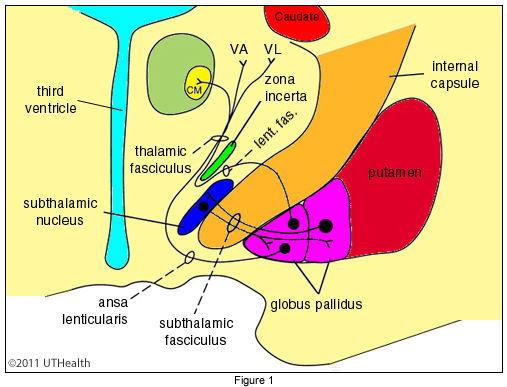Lab 5 (ƒ8) - Higher Motor Function
Basal Ganglia
The basal ganglia include the corpus striatum (which is comprised of the caudate and lenticular nuclei), the subthalamic nucleus (which is part of the diencephalon) and the substantia nigra (which is part of the midbrain). The neostriatum (i.e., the caudate and putamen) receives axons from the cerebral cortex (major input), substantia nigra, and intralaminar nuclei (CM) of the thalamus and sends its axons to the globus pallidus and substantia nigra.  Consequently, the neostriatum affects motor activity through these structures (i.e., the globus pallidus and substantial nigra).
Consequently, the neostriatum affects motor activity through these structures (i.e., the globus pallidus and substantial nigra).
The globus pallidus sends its axons to the VA,VL and CM thalamic nuclei and, in addition, sends axons to and receives axons from the subthalamic nucleus. Lesions of the subthalamic nucleus produce a distinctive movement disorder called hemiballismus that is characterized by flailing movements of the contralateral limbs. The ansa lenticularis and lenticular fasciculus carry globus pallidus axons to the VA, VL and CM thalamic nuclei, and the subthalamic fasciculus carries information between the globus pallidus and subthalamic nucleus.
The substantia nigra sends axons back to the neostriatum, to the VL and VA thalamic nuclei and to the superior colliculus and reticular formation. It also receives a smaller input from the globus pallidus and subthalamic nucleus. The projection back to the neostriatum is via a dopaminergic pathway. Damage to this pathway produces the symptoms of Parkinson's disease.

